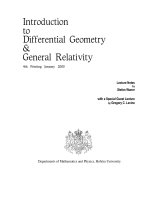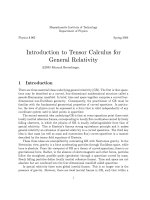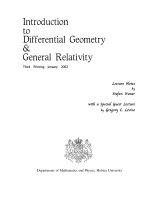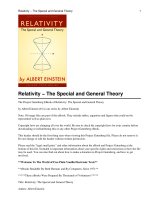Intro to Differential Geometry and General Relativity - S. Warner Episode 13 pptx
Bạn đang xem bản rút gọn của tài liệu. Xem và tải ngay bản đầy đủ của tài liệu tại đây (144.02 KB, 8 trang )
121
3. Calculate the Riemann coordinates of curvature tensor R
abcd
at the event horizon. r =
2M.
16. White Dwarfs, Neutron Stars and Black Holes—Guest Lecture by Gregory C.
Levine
I Introduction
In this section we will look at the physical mechanisms responsible for the formation
compact stellar objects. Compact objects such as white dwarf stars, neutron stars, and
ultimately black holes, represent the final state of a star's evolution. Stars are born in
gaseous nebulae in which clouds of hydrogen coalesce becoming highly compressed and
heated through the gravitational interaction. At a temperature of about 10
7
K, a nuclear
reaction begins converting hydrogen into the next heavier element, helium, and releasing a
large quantity of electromagnetic energy (light). The helium accumulates at the center of the
star and eventually becomes compressed and heated enough (10
8
K) to initiate nuclear
fusion of helium into heavier elements.
So far, the star is held in "near-equilibrium" by the countervailing forces of gravity, which
compresses the star, and pressure from the vast electromagnetic energy produced during
nuclear fusion, which tends to make it expand. However, as the star burns hotter and
ignites heavier elements which accumulate in the core, electromagnetic pressure becomes
less and less effective against gravitational collapse. In most stars, this becomes a serious
problem when the core has reached the carbon rich phase but the temperature is still
insufficient to fuse carbon into iron. Even if a star has reached sufficient temperature to
create iron, no other nuclear fusion reactions producing heavier elements are exothermic
and the star has exhausted its nuclear fuel. Without electromagnetic energy to hold the core
up, one would think that the core would become unstable and begin to collapse but
another mechanism intervenes.
II The Electron Gas
But there is another "force" that holds the core up; now we will turn to a study of this force
and how the balance between this force and gravity lead to the various stellar compact
objects: white dwarfs, neutron stars and black holes.
The stabilizing force that keeps the stellar core from collapsing operates at terrestrial scales
as well. All solid matter resists compression and we will trace the origin of this behavior in
a material that turns out to most resemble a stellar compact object: ordinary metal.
Although metal is "hard" by human standards, it is to some degree elastic capable of
stretching and compression. Metals all have a similar atomic structure. Positively charged
metal ion cores form a regular crystalline lattice and negatively charged valence electrons
form a kind of gas that uniformly permeates the lattice.
122
+ ++ + +
++ + +
+ ++ + +
+ ++ + +
+
Suprisingly, the bulk properties of the metal such as heat capacity, compressibility, and
thermal conductivity are almost exclusively properties of the electron gas and not the
underlying framework of the metal ion cores. We will begin by studying the properties of
an electron gas alone and then see if it is possible to justify such a simple model for a metal
(or a star).
To proceed, two very important principles from Quantum Mechanics need to be
introduced:
Pauli Exclusion Principle: Electrons cannot be in the same quantum state. For our
purposes, this will effectively mean that electrons cannot be at the same point in space.
Heisenberg Uncertainty Principle: A quantum particle has no precise position, x, or
momentum, p. However, the uncertainties in the outcome of experiment aimed at
simultaneously determining both quantities is constrained in the following way. Upon
repeated measurements, the "spread" in momentum, ∆p, of a particle absolutely confined to
a region in space of size∆x, is constrained by
∆x∆p ≥
2
where ‡ 6.6¿10
-34
Joule-sec is a fundamental constant of nature (the Planck
constant).
Here is how these two laws act together to give one of the familiar properties of metals.
The Pauli Exclusion Principle tends to make electrons stay as far apart as possible. Each of
N electrons confined in a box of volume R
3
will typically have R
3
/N space of its own.
Therefore, the average interparticle spacing is a
0
= R/N
1/3
. (The situation is actually a bit
more complicated than this *link*). Since the electrons are spatially confined within a
region of linear size a
0
, the uncertainty in momentum is ∆p ‡ /a
0
. The precise meaning
of ∆p
2
is the variance of a large set of measurements of momentum. Denoting average by
angle brackets,
∆p
2
= “(p - “p‘)
2
‘ = “p
2
‘ - “p‘
2
.
123
Therefore, the average value of p
2
must be greater than or equal to∆p
2
.
Based on these results, let us calculate how the energy of an electron gas depends upon the
size of the box containing it. The kinetic energy of a particle of mass m and speed v is
œ =
1
2
mv
2
=
p
2
2m
Now, taking the minimum value of momentum, p
2
‡ ∆p
2
‡
2
/a
0
2
, we arrive at the
energy, œ =
2
/m
e
a
0
2,
, for a single electron of mass m
e
. The total kinetic energy of N
electrons is then E
e
= Nœ. Finally, putting in the dependence of a
0
on N and the system
size, R, we get for E
e
,
E
e
‡
2
m
e
R
2
N
5/3
.
As the system size R is reduced, the energy increases. Even though the electrons do not
interact with one another, there is an effective repulsive force resisting compression. The
origin of this force is the uncertainty principle! (neglecting e-e interactions and neglecting
temperature.)
Let us test out this model by calculating the compressibility of metal. Consider a metal
block that undergoes a small change in volume, ∆V, due to an applied pressure P.
P
∆V
The bulk modulus, B, is defined as the constant of proportionality between the applied
pressure and the fractional volume change.
P = B
∆V
V
.
The outward pressure (towards positive R) exerted by the electron gas is defined in the
usual way in terms of a derivative of the total energy of the system:
124
P =
F
A
= -
1
A
∂E
e
∂R
The bulk modulus is then defined as
B = V
∂P
∂V
= -
5
9
2
m
e
N
V
5/3
‡ 10
-10
- 10
-11
N/m
2
.
(We've taken the volume per electron to be 1 nm
3
.) The values of B for Steel and
Aluminum are B
steel
‡ 6¿10
-10
N/m
2
and B
Al
‡ 2¿10
-10
N/m
2
. It is hard to imagine that
this excellent agreement in magnitude is wholly fortuitous (it is not). Having seen that the
Heisenberg uncertainty principle is the underlying physics behind the rigidity of metal, we
will now see that it is also physical mechanism that keeps stars from collapsing under their
own weight.
III Compact Objects
A star can only be in a condition of static equilibrium if there is some force to counteract the
compressive force of gravity. In large stars this countervailing force is the radiation
pressure from thermally excited atoms emitting light. But in a white dwarf star, the force
counteracting gravity has its origin in the uncertainty principle, as it did in a metal. The
elements making up the star (mostly iron) exist in a completely ionized state because of the
high temperatures. One can think of the star as a gas of positive charge atomic nuclei and
negative charge electrons. Each metal nucleus is a few thousand times heavier than the set
of electrons that were attached to it, so the nuclei (and not the electrons) are responsible for
the sizable gravitational force holding the star together. The electrons are strongly
electrostatically bound to core of the star and therefore coexist in the same volume as the
nuclear core gravity pulling the nuclei together and the uncertainty principle effectively
pushing the electrons apart.
+
+
+
+
+
+
+
+
+
+
+
+
We will proceed in the same way as in the calculation of the bulk modulus by finding an
expression for the total energy and taking its derivative with respect to R to find the
effective force.
The gravitational potential energy of sphere of mass M and radius R is approximately
125
E
g
‡ -
GM
2
R
where G ‡ 7 ¿ 10
-11
Nm
2
/kg
2
is the gravitational constant. (The exact result has a coeffient
of order unity in front; we are doing only "order-of-magnitude" calculations and ignoring
such factors.) The negative sign means that the force of gravity is attractive energy
decreases with decreasing R. We would like to express E
g
in terms of N, like E
e
this will
make the resulting expressions easier to adapt to neutron stars later on. The mass M of the
star is the collective mass of the nucleons, to an excellent approximation. As you may
know from chemisty, the number of nucleons (protons and neutrons) is roughly double the
number of electrons, for light elements. If µ is the average number of nucleons per
electron, for the heavier elements making up the star, The mass of the star is expressed as
M=µm
n
N. Putting the expressions for the electron kinetic energy and the gravitational
potential energy together, we get the total energy E:
E = E
e
+ E
g
‡
2
N
5/3
m
e
R
2
-
Gµ
2
m
n
2
N
2
R
.
The graph of the function E(R)
E
R
R
reveals that there is a radius at which the energy is minimum that is to say, a radius R
0
where the force F = -∂E/∂R is zero and the star is in mechanical equilibrium. A rough
calculation of R
0
gives:
R
0
=
2
N
-1/3
Gm
e
µ
2
m
n
2
‡ 10
7
m = 10,000 km.
where we have used N ‡ 10
57
, a reasonable value for a star such as our sun. R
0
corresponds to a star that is a little bigger than earth a reasonable estimate for a white
126
dwarf star! The mass density ® may also be calculated assuming the radius R
0
: ® ‡ 10
9
kg/m
3
= 10
5
¿ density of steel. On the average, the electrons are much closer to the nuclei
in the white dwarf than they are in ordinary matter.
Under some circumstances, the star can collapse to an object even more compact than a
white dwarf a neutron star. The Special Theory of Relatvity plays an important role in
this further collapse. If we calculate the kinetic energy of the most energetic electrons in the
white dwarf, we get:
œ ‡
2
m
e
a
0
2
=
2
m
e
N
R
0
2/3
‡ 100
-14
Joules.
This energy is actually quite close to the rest mass energy of the electron itself, m
e
c
2
= 10
-
13
Joules. Recall that the expression for the kinetic energy, œ = p
2
/2m, is only a
nonrelativistic approximation. Rest mass energy is a scalar formed from the product
p
µ
p
µ
=
œ
2
c
2
- p
2
= (mc)
2
.
The exact expression for the energy œ of a relativistic particle is then:
œ = (pc)
2
+(mc
2
)
2
= mc
2
+
p
2
2m
+ terms of order ≥
p
mc
4
.
When p ‡ mc (or, equivalently, when p
2
/m ‡ mc
2
as above) the higher order terms cannot
be neglected.
Since the full expression for œ is unwieldy for our simple approximation schemes, we will
look at the extreme relativistic limit, p >> mc. In this case, œ ‡ pc. This limit is effectively
the limit for extremely massive stars, where the huge compressive force of gravity will
force the electrons to have compensatingly high kinetic energies and enter the extreme
relativistic regime.
The different form for the energy of the electrons (now linear rather than quadratic in p)
will have dramatic consequences for the stability equation for the radius R
0
derived earlier.
The calculation proceeds as before; according to the uncertainty principle the estimate for
the momentum of an electron within the star is
p =
a
0
=
N
1/3
R
.
Therefore, the total electron energy is given by
E
e
‡ Nœ ‡ Npc ‡
cN
4/3
R
127
The same expression as before for E
g
results in the following expression for the total
energy:
E + E
e
+ E
g
‡
cN
4/3
R
-
Gµ
2
m
n
2
N
2
R
.
The energy E(R) has a completely different behavior than in the nonrelativistic case. If we
look at the force F = -∂E/∂R it is just equal to E/R. If the total energy is positive, the force
always induces expansion; if the total energy is negative, the force always induces
compression. Thus, if the total energy E is negative, the star will continue to collapse (with
an ever increasing inward force) unless some other force intervenes. These behaviors are
suggested in the figure below.
F
R
Neutron star or ??
N < N
C
N > N
C
The expression for total energy tells us that the critical value of N (denoted by N
C
) for
which the energy crosses over to negative value is
N
C
=
1
µ
3
c
Gm
n
2
3/2
.
This is conventionally written in terms of a critical mass for a star, M
C
, that separates the
two behaviors: expansion or collapse. The critical mass is
M
C
= µN
c
m
n
=
1
µ
2
m
n
2
c
G
3/2
.
If M > M
C
, the star will continue to collapse and its electrons will be pushed closer and
closer to the nuclei. At some point, a nuclear reaction begins to occur in which electrons
128
and protons combine to form neutrons (and neutrinos which are nearly massless and
noninteracting). A sufficiently dense star is unstable against such an interaction and all
electrons and protons are converted to neutrons leaving behind a chargeless and
nonluminous star: a neutron star.
You may be wondering: what holds the neutron star up? Neutrons are chargeless and the
nuclear force between neutrons (and protons) is only attractive, so what keeps the neutron
star from further collapse? Just as with electrons, neutrons obey the Pauli Exclusion
Principle. Consequently, they avoid one another when they are confined and have a sizable
kinetic energy due to the uncertainty principle. If the neutrons are nonrelativistic, the
previous calculation for the radius of the white dwarf star will work just the same, with the
replacement m
e
’ m
n
. This change reduces the radius R
0
of the neutron star by a factor
of ‡2000 (the ratio of m
n
to m
e
) and R
0
‡ 10 km. One of these would comfortably fit on
Long Island but would produce somewhat disruptive effects.
Finally, if the neutron star is massive enough to make its neutrons relativistic, continued
collapse is possible if the total energy is negative, as before in the white dwarf case. The
expression for the critical mass M
C
is easily adapted to neutrons by setting µ = 1. Since µ
‡ 2 for a white dwarf, we would expect that a star about four times more massive than a
white dwarf is susceptible to unlimited collapse. No known laws of physics are capable of
interrupting the collapse of a neutron star. In a sense, the laws of physics leave the door
open for the formation of stellar black holes.
References and Suggested Further Reading
(Listed in the rough order reflecting the degree to which they were used.)
Bernard F. Schutz, A First Course in General Relativity (Cambridge University Press,
1986
David Lovelock and Hanno Rund, Tensors, Differential Forms, and Variational
Principles (Dover, 1989)
Charles E. Weatherburn, An Introduction to Riemannian Geometry and the Tensor
Calculus (Cambridge University Press, 1963)
Charles W. Misner, Kip S. Thorne and John A. Wheeler, Gravitation (W.H. Freeman,
1973)
Keith R. Symon, Mechanics (3rd. Ed. Addison Wesley)









